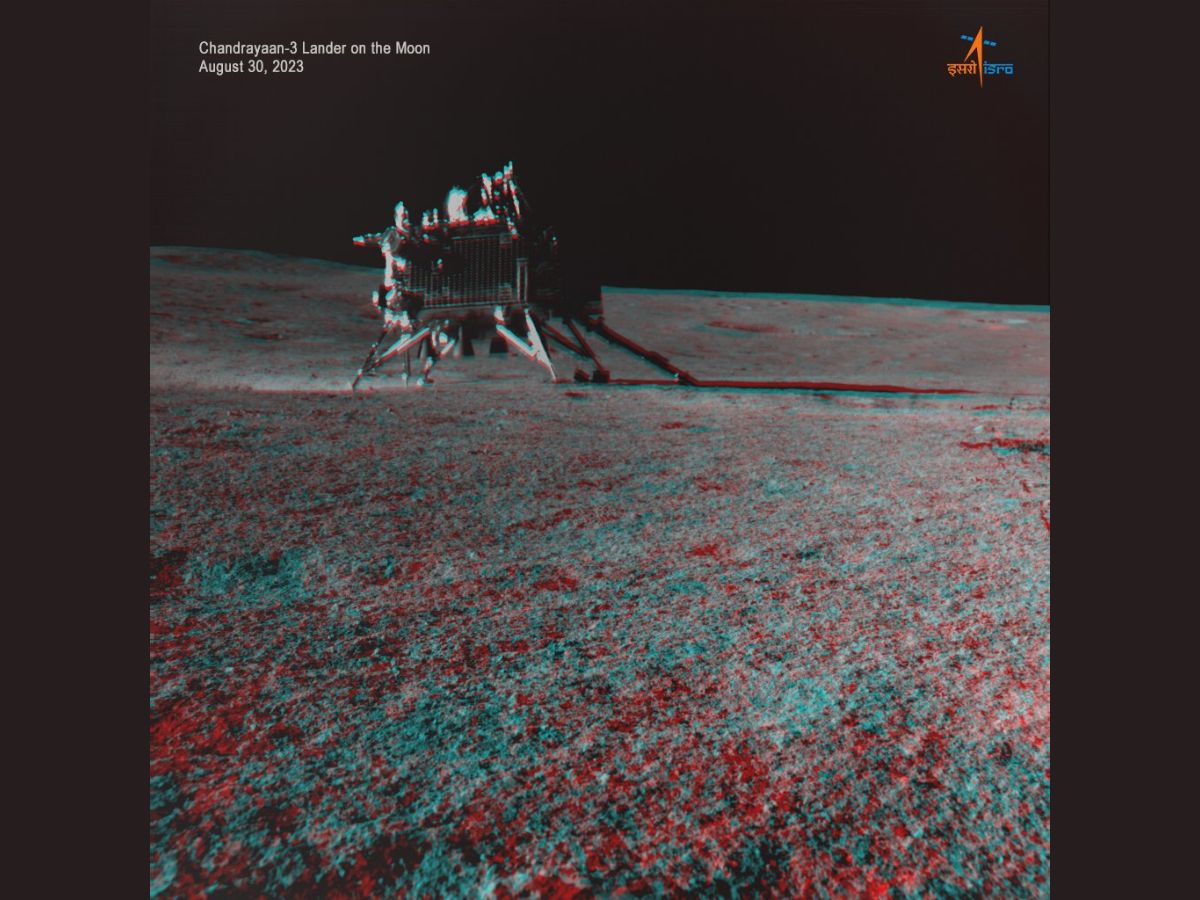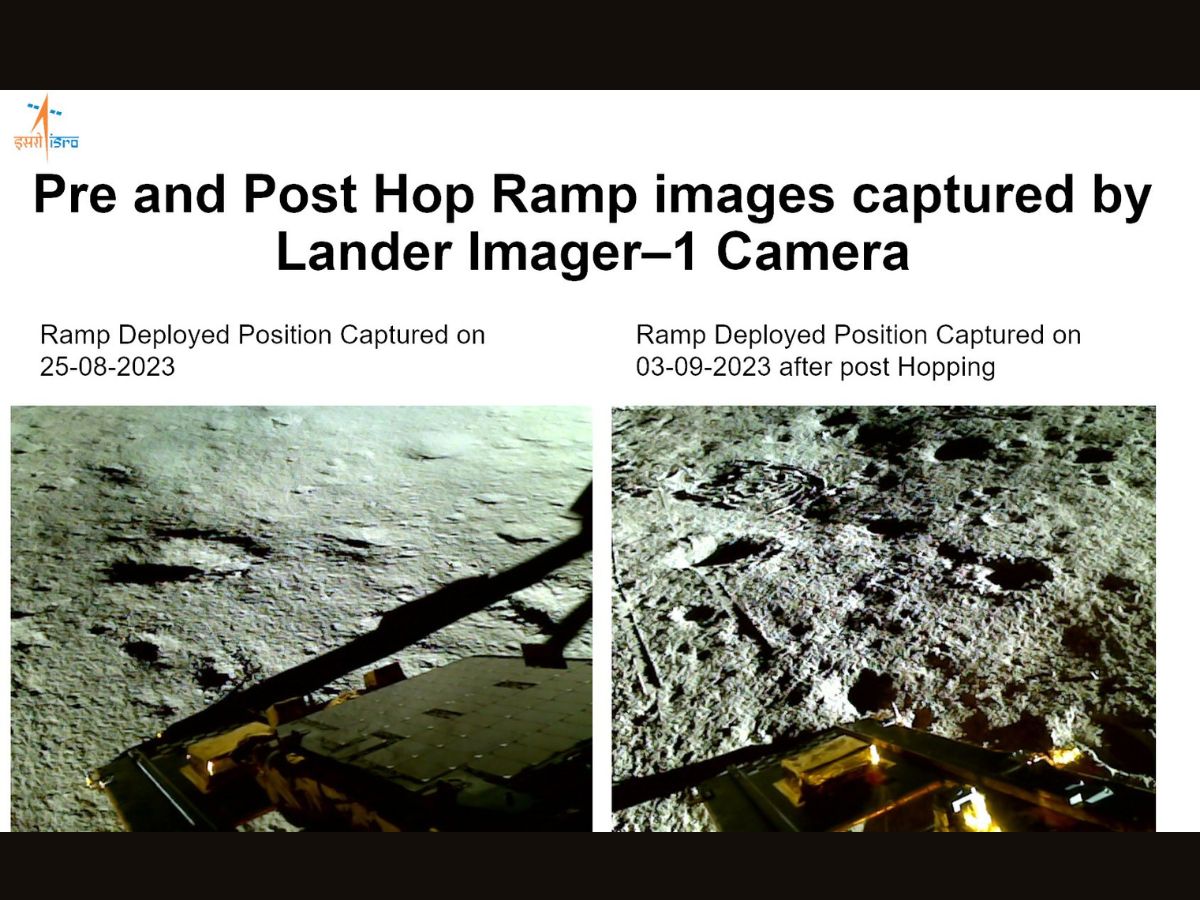Chandrayaan-3: ISRO Shares ‘Anaglyph’ Of Vikram Lander On The Moon Captured By Pragyan Rover. Know What It Means
Chandrayaan-3: Pragyan rover captured images of Vikram in both left and right directions. Together, these are called NavCam Stereo images. ISRO created the anaglyph using these images.

Chandrayaan-3: The Indian Space Research Organisation (ISRO) has shared an “anaglyph” of the Vikram lander on the Moon captured by the Navigation Camera onboard the Pragyan rover. The camera captured images of Vikram in both left and right directions. Together, these are called NavCam Stereo images. ISRO created the anaglyph using these images.
In photography, an anaglyph is a stereoscopic or composite picture printed by superimposing two images of the same object in different directions, and in different colours. These colours are usually red and green. When viewed using certain filters, a stereo effect is created, which means that one will have the visual impression of three dimensions.
Chandrayaan-3 Mission:
— ISRO (@isro) September 5, 2023
Anaglyph is a simple visualization of the object or terrain in three dimensions from stereo or multi-view images.
The Anaglyph presented here is created using NavCam Stereo Images, which consist of both a left and right image captured onboard the Pragyan… pic.twitter.com/T8ksnvrovA
Therefore, an anaglyph is a visualisation of an object or terrain in three dimensions created using multi-view images.

According to ISRO, the anaglyph of Vikram created using images captured by Pragyan’s camera is a three-channel image. This means that three different colours have been superimposed. However, the number of images used is two.
MUST READ | Science For Everyone: Why It Is Important To Study The Sun, And How Aditya-L1 Will Do So
ISRO has positioned the left image in the red channel, and the right image in the blue and green channels, creating a cyan effect. Since there is a difference in perspective between the two pictures, a stereo effect is created.
ISRO has recommended that people view the anaglyph in red and cyan glasses to enjoy the stereo or three-dimensional effect.
ALSO READ | What Will Happen To Chandrayaan-3 After Its Mission Ends?
Vikram Put Into Sleep Mode
On September 4, 2023, at 8 pm IST, Vikram was put into sleep mode. Before that, Chandra's Surface Thermophysical Experiment (ChaSTE), Instrument for Lunar Seismic Activity (ILSA), and Radio Anatomy of Moon Bound Hypersensitive ionosphere and Atmosphere-Langmuir Probe (RAMBHA-LP) performed in-situ experiments at a new location. ISRO has received the data collected by the payloads. Similar to Pragyan, Vikram’s receivers have been kept ‘ON’. Once Vikram’s solar power is depleted, and its battery is drained, the lander will fall asleep next to Pragyan.
ISRO hopes that Vikram will wake up again sometime around September 22, 2023, when the next lunar sunrise will occur.
MUST READ: EXCLUSIVE | Chandrayaan-3 Is A 'Huge Confidence Booster', Can Help Reverse Brain Drain, CERN Scientist Archana Sharma Says
Vikram Soft-Landed On Moon Again
On September 4, Vikram soft-landed on the Moon again by successfully undergoing a hop experiment. ISRO wrote on X (formerly Twitter) that Vikram exceeded its mission objectives by performing this hop.
Chandrayaan-3 Mission:
— ISRO (@isro) September 4, 2023
🇮🇳Vikram soft-landed on 🌖, again!
Vikram Lander exceeded its mission objectives. It successfully underwent a hop experiment.
On command, it fired the engines, elevated itself by about 40 cm as expected and landed safely at a distance of 30 – 40 cm away.… pic.twitter.com/T63t3MVUvI
ISRO sent commands to Vikram to fire its engines, following which the lander elevated itself by 40 centimetres. After this, Vikram safely landed at a location 30 to 40 centimetres away from the place where it performed the hop.

According to ISRO, this ‘kick-start’ is important because it demonstrates the Indian space agency’s ability to conduct future sample return and human missions.
After the hop experiment, all the systems onboard Vikram were performing nominally, and were healthy, and the deployed ramp, and ChaSTE and ISLA payloads were folded back.

Before being put to sleep, the payloads were successfully redeployed.
Pragyan was put into sleep mode on September 2.
Related Video
Southern Rising Summit 2024: How Important is Self-Awareness? Insights from Anu Aacharya | ABP LIVE
Top Headlines






































